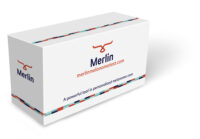Can my patient safely forgo the sentinel lymph node biopsy?
Sentinel lymph node biopsy referral can be challenging
Especially for the group of melanoma patients for which the guidelines recommend to “discuss and consider/offer” the surgery.1
The SLNB is considered the standard of care to determine the clinical stage of the disease and guide appropriate treatment decisions. Still, this is an invasive surgery that may expose a patient to >10% risk of surgery-related complications.2
Furthermore, studies show that the wide majority (80-85%) of melanoma patients who undergo the surgery are negative for nodal metastasis (SLNB -).3 While some patients may require this procedure, many may be able to avoid an SLNB due to the absence of nodal metastases and consequently avoid risks associated with the surgery such as infection, seroma, hematoma and lymphedema.2
The Merlin test addresses this clinical unmet need by triaging cutaneous melanoma patients for sentinel lymph node biopsy based on their risk for nodal metastasis.
Merlin test at a glance
The test identifies primary cutaneous melanoma patients at low risk for nodal metastasis who may therefore forgo a sentinel lymph node biopsy procedure.
T1-T2 melanomas account for ~86% of the newly diagnosed melanomas. For this group of patients, guidelines recommend to “discuss and consider/offer” the SLNB surgery.1
Merlin provides unique insights on the aggressiveness of your patient’s melanoma
Current treatment decisions are made based on clinicopathologic factors such as patient’s age, Breslow thickness, ulceration. However, these variables do not always provide a complete view of your patient’s melanoma and the individual corresponding risks.
With the Merlin test, you can gain a deeper understanding of your patient’s cancer with no additional procedure required.
The Merlin test uses the CP-GEP model, an algorithm developed by logistic regression modeling. The combination of clinicopathologic factors – patient’s age and Breslow thickness – with the gene expression profiling component of 8 specific genes involved in cancer metastasis and melanosome biogenesis, will allow you to better understand your patient’s risk and may optimize a personalized treatment plan.
The Merlin test supports your decision-making
The Merlin test may help you optimize the clinical management of each patient. Validation studies in the United States and Europe confirm that the test accurately identifies patients who have a low risk for nodal metastasis. The test provides a binary result:
The Merlin test has a rapid turnaround time (6 hours and 25 minutes), and makes use of the biopsy tissue collected for diagnosis.
Low Risk Report
High Risk Report
Merlin may reduce the number of SLNB-related complications by 59% if Merlin Low Risk patients would forgo the SLNB surgery.5

Tissue requirements
- 5 x 10 microns formalin fixed and paraffin embedded (FFPE) tissue of primary cutaneous melanoma biopsy.
- No macrodissection is needed.
The Merlin test is now available as CE-IVD product in Europe. Soon to be available also on Idylla™ platform8.
Merlin test indication
Utility
Identify primary cutaneous melanoma patients who have a low risk of having nodal metastasis and may therefore forgo the sentinel lymph node biopsy.
Intended use population
SLNB eligible patients:
- NCCN Guidelines 2022 version 1
- Moody JA, Ali RF, Carbone AC, et al: Complications of sentinel lymph node biopsy for melanoma – A systematic review of the literature. Eur J Surg Oncol 43:270-277, 2017
- Morton DL, Thompson JF, Cochran AJ, et al: Final trial report of sentinel-node biopsy versus nodal observation in melanoma. N Engl J Med 370:599-609, 2014
- Shaikh WR, Dusza SW, Weinstock MA, et al: Melanoma Thickness and Survival Trends in the United States, 1989-2009. J Natl Cancer Inst. 2016
- Hieken, T.J., Sadurní, M.B., Quattrocchi, et al: Using the Merlin assay for reducing sentinel lymph node biopsy complications in melanoma: a retrospective cohort study. Int J Dermatol. 2022
- Johansson I, Tempel D, Dwarkasing D, et al. Validation of a clinicopathological and gene expression profile model to identify patients with cutaneous melanoma where sentinel lymph node biopsy is unnecessary. EJSO. 2021: DOI 10.1016/j. ejso.2021.11.010.
- Bellomo D, Arias-Mejias S, Ramana C, et al. A model combining tumor molecular and clinicopathologic risk factors predicts sentinel lymph node metastasis in primary cutaneous melanoma. JCO Precis Oncol. 2020:DOI 10.1200/PO.19.00206.
- Idylla Platform | Biocartis